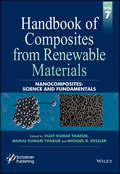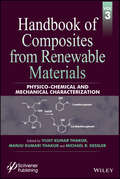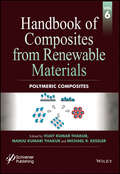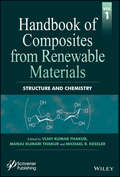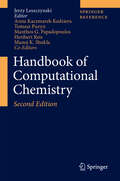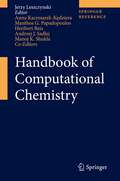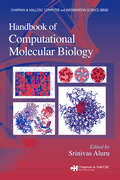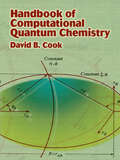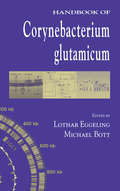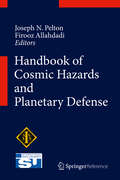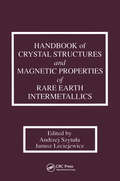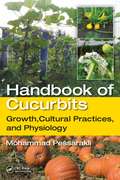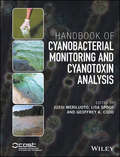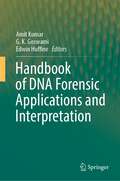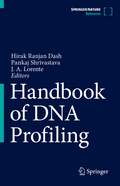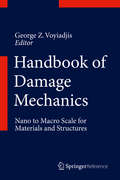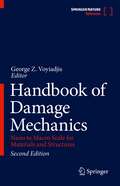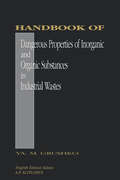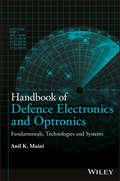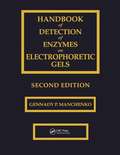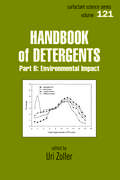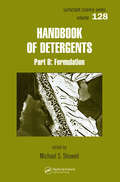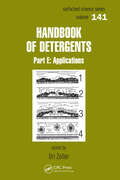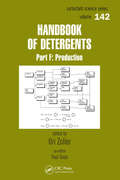- Table View
- List View
Handbook of Composites from Renewable Materials, Nanocomposites: Advanced Applications
by Vijay Kumar Thakur Manju Kumari Thakur Michael R. KesslerThe Handbook of Composites From Renewable Materials comprises a set of 8 individual volumes that brings an interdisciplinary perspective to accomplish a more detailed understanding of the interplay between the synthesis, structure, characterization, processing, applications and performance of these advanced materials. The handbook covers a multitude of natural polymers/ reinforcement/ fillers and biodegradable materials. Together, the 8 volumes total at least 5000 pages and offers a unique publication.This 8th volume of the Handbook is solely focused on the Nanocomposites: Advanced Applications. Some of the important topics include but not limited to: virgin and recycled polymers applied to advanced nanocomposites; biodegradable polymer-carbon nanotube composites for water and wastewater treatment; eco-friendly nanocomposites of chitosan with natural extracts, antimicrobial agents and nanometals; controllable generation of renewable nanofibrils from green materials and their application in nanocomposites; nanocellulose and nanocellulose composites; poly (lactic acid) biopolymer composites and nanocomposites for biomedical and biopackaging applications; impact of nanotechnology in water treatment: carbon nanotube and graphene; nanomaterials in energy generation; sustainable green nanocomposites from bacterial bioplastics for food packaging applications; PLA-nanocomposites: a promising material for future from renewable resources; bio-composites from renewable resources: preparation and applications of chitosan-clay nanocomposites; nano materials: an advanced and versatile nano additive for kraft and paper industries; composites and nanocomposites based on polylactic acid obtaining; cellulose-containing scaffolds fabricated by electrospinning: applications in tissue engineering and drug delivery; biopolymer-based nanocomposites for environmental applications; calcium phosphate nanocomposites for biomedical and dental applications: recent developments; chitosan-metal nanocomposites: synthesis, characterization and applications; multi-carboxyl functionalized nano-cellulose/nano-bentonite composite for the effective removal and recovery of metal ions; biomimetic gelatin nanocomposite as a scaffold for bone tissue repair; natural starches-blended ionotropically-gelled microparticles/beads for sustained drug release and ferrogels: smart materials for biomedical and remediation applications.
Handbook of Composites from Renewable Materials, Nanocomposites: Science and Fundamentals
by Vijay Kumar Thakur Manju Kumari Thakur Michael R. KesslerThe Handbook of Composites From Renewable Materials comprises a set of 8 individual volumes that brings an interdisciplinary perspective to accomplish a more detailed understanding of the interplay between the synthesis, structure, characterization, processing, applications and performance of these advanced materials. The handbook covers a multitude of natural polymers/ reinforcement/ fillers and biodegradable materials. Together, the 8 volumes total at least 5000 pages and offers a unique publication.This 7th volume Handbook is solely focused on Nanocomposites: Science and Fundamentals. Some of the important topics include but not limited to: preparation, characterization and applications of nano materials from renewable resources; hydrogels and its nanocomposites from renewable resources: preparation of chitin-based nanocomposite materials through gelation with ionic liquid; starch based bionanocomposites; biorenewable nanofiber and nanocrystal; investigation of wear characteristics of dental composite reinforced with rice husk derived nanosilica filler particles; performance of regenerated cellulose/vermiculite nanocomposites fabricated via ionic liquid; preparation, structure, properties and interactions of the PVA/cellulose composites; green composites with cellulose nano-reinforcements; biomass composites from bamboo-based micro/nano fibers; synthesis and medicinal properties of polycarbonates and resins from renewable sources; nanostructured polymer composites with modified carbon nanotubes; organic-inorganic nanocomposites derived from polysaccharides; natural polymer based nanocomposites; cellulose whisker based green polymer composites; poly (lactic acid) nanocomposites reinforced with different additives; nanocrystalline cellulose; halloysite based bionanocomposites; nanostructurated composites based on biodegradable polymers and silver nanoparticles; starch-based biomaterials and nanocomposites; green nanocomposites based on PLA and natural organic fillers; chitin and chitosan based nanocomposites.
Handbook of Composites from Renewable Materials, Physico-Chemical and Mechanical Characterization
by Vijay Kumar Thakur Manju Kumari Thakur Michael R. KesslerThe Handbook of Composites From Renewable Materials comprises a set of 8 individual volumes that brings an interdisciplinary perspective to accomplish a more detailed understanding of the interplay between the synthesis, structure, characterization, processing, applications and performance of these advanced materials. The handbook covers a multitude of natural polymers/ reinforcement/ fillers and biodegradable materials. Together, the 8 volumes total at least 5000 pages and offers a unique publication. This 3rd volume of the Handbook is solely focused on the Physico-Chemical and Mechanical Characterization of renewable materials. Some of the important topics include but not limited to: structural and biodegradation characterization of supramolecular PCL/HAP nano-composites; different characterization of solid bio-fillers based agricultural waste material; poly (ethylene-terephthalate) reinforced with hemp fibers; poly (lactic acid) thermoplastic composites from renewable materials; chitosan –based composite materials: fabrication and characterization; the use of flax fiber reinforced polymer (FFRP) composites in the externally reinforced structures for seismic retrofitting monitored by transient thermography and optical techniques; recycling and reuse of fiber reinforced polymer wastes in concrete composite materials; analysis of damage in hybrid composites subjected to ballistic impacts; biofiber reinforced acrylated epoxidized soybean oil (AESO) biocomposites; biopolyamides and high performance natural fiber-reinforced biocomposites; impact of recycling on the mechanical and thermo-mechanical properties of wood fiber based HDPE and PLA composites; lignocellulosic fibers composites: an overview; biodiesel derived raw glycerol to value added products; thermo-mechanical characterization of sustainable structural composites; novel pH sensitive composite hydrogel based on functionalized starch/clay for the controlled release of amoxicillin; preparation and characterization of biobased thermoset polymers from renewable resources; influence of natural fillers size and shape into mechanical and barrier properties of biocomposites; composite of biodegradable polymer blends of PCL/PLLA and coconut fiber - the effects of ionizing radiation; packaging composite materials from renewable resources; physicochemical properties of ash based geopolymer concrete; a biopolymer derived from castor oil polyurethane; natural polymer based biomaterials; physical and mechanical properties of polymer membranes from renewable resources
Handbook of Composites from Renewable Materials, Polymeric Composites
by Vijay Kumar Thakur Manju Kumari Thakur Michael R. KesslerThe Handbook of Composites From Renewable Materials comprises a set of 8 individual volumes that brings an interdisciplinary perspective to accomplish a more detailed understanding of the interplay between the synthesis, structure, characterization, processing, applications and performance of these advanced materials. The handbook covers a multitude of natural polymers/ reinforcement/ fillers and biodegradable materials. Together, the 8 volumes total at least 5000 pages and offers a unique publication. This 6th volume Handbook is solely focused on Polymeric Composites. Some of the important topics include but not limited to: Keratin as renewable material for developing polymer composites; natural and synthetic matrices; hydrogels in tissue engineering; smart hydrogels: application in bioethanol production; principle renewable biopolymers; application of hydrogel biocomposites for multiple drug delivery; nontoxic holographic materials; bioplasticizer - epoxidized vegetable oils-based poly (lactic acid) blends and nanocomposites; preparation, characterization and adsorption properties of poly (DMAEA) – cross-linked starch gel copolymer in waste water treatments; study of chitosan crosslinking hydrogels for absorption of antifungal drugs using molecular modelling; pharmaceutical delivery systems composed of chitosan; eco-friendly polymers for food packaging; influence of surface modification on the thermal stability and percentage of crystallinity of natural abaca fiber; influence of the use of natural fibers in composite materials assessed on a life cycle perspective; plant polysaccharides-blended ionotropically-gelled alginate multiple-unit systems for sustained drug release; vegetable oil based polymer composites; applications of chitosan derivatives in wastewater treatment; novel lignin-based materials as a products for various applications; biopolymers from renewable resources and thermoplastic starch matrix as polymer units of multi-component polymer systems for advanced applications; chitosan composites: preparation and applications in removing water pollutants and recent advancements in biopolymer composites for addressing environmental issues.
Handbook of Composites from Renewable Materials, Structure and Chemistry
by Vijay Kumar Thakur Manju Kumari Thakur Michael R. KesslerThe Handbook of Composites From Renewable Materials comprises a set of 8 individual volumes that brings an interdisciplinary perspective to accomplish a more detailed understanding of the interplay between the synthesis, structure, characterization, processing, applications and performance of these advanced materials. The handbook covers a multitude of natural polymers/ reinforcement/ fillers and biodegradable materials. Together, the 8 volumes total at least 5000 pages and offers a unique publication. Volume 1 is solely focused on the Structure and Chemistry of renewable materials. Some of the important topics include but not limited to: carbon fibers from sustainable resources; polylactic acid composites and composite foams based on natural fibres; composites materials from other than cellulosic resources; microcrystalline cellulose and related polymer composites; tannin-based foam; renewable feedstock vanillin derived polymer and composites; silk biocomposites; bio-derived adhesives and matrix polymers; biomass based formaldehyde-free bio-resin ; isolation and characterization of water soluble polysaccharide; bio-based fillers; keratin based materials in biotechnology; structure of proteins adsorbed onto bioactive glasses for sustainable composite; effect of filler properties on the antioxidant response of starch composites; composite of chitosan and its derivate; magnetic biochar from discarded agricultural biomass; biodegradable polymers for protein and peptide conjugation; polyurethanes and polyurethane composites from bio-based / recycled components.
Handbook of Computational Chemistry
by Jerzy Leszczynski Tomasz Puzyn Manthos G. Papadopoulos Manoj K. Shukla Anna Kaczmarek-Kedziera Heribert ReisThe first part briefly describes different methods used in computational chemistry without going into exhaustive details of theory. Basic assumptions common to the majority of computational methods based on either quantum or statistical mechanics are outlined. Particular attention is paid to the limits of their applicability. The second part consists of a series of sections exemplifying the various, most important applications of computational chemistry. Molecular structures, modeling of various properties of molecules and chemical reactions are discussed. Both ground and excited state properties are covered in the gas phase as well as in solutions. Solid state materials and nanomaterials are described in part three. Amongst the topics covered are clusters, periodic structures, and nano-systems. Special emphasis is placed on the environmental effects of nanostructures. Part four is devoted to an important class of materials - biomolecules. It focuses on interesting models for biological systems that are studied by computational chemists. RNA, DNA, and proteins are discussed in detail. Examples are given for calculations of their properties and interactions. The role of solvents in biologically significant reactions is revealed, as well as the relationship between molecular structure and function of various classes of biomolecules. Part five features new bonus material devoted to Chemoinformatics. This area is vital for many applications of computational methods. The section includes a discussion of basic ideas such as molecular structure, molecular descriptors and chemical similarity. Additionally, QSAR techniques and screening methods are covered. Also, available open source chemoinformatics software is presented and discussed.
Handbook of Computational Chemistry
by Jerzy LeszczynskiThe role the Handbook of Computational Chemistry is threefold. It is primarily intended to be used as a guide that navigates the user through the plethora of computational methods currently in use; it explains their limitations and advantages; and it provides various examples of their important and varied applications. This reference work is presented in three volumes. Volume I introduces the different methods used in computational chemistry. Basic assumptions common to the majority of computational methods based on molecular, quantum, or statistical mechanics are outlined and special attention is paid to the limits of their applicability. Volume II portrays the applications of computational methods to model systems and discusses in detail molecular structures, the modelling of various properties of molecules and chemical reactions. Both ground and excited states properties are covered in the gas phase as well as in solution. This volume also describes Nanomaterials and covers topics such as clusters, periodic, and nano systems. Special emphasis is placed on the environmental effects of nanostructures. Volume III is devoted to the important class of Biomolecules. Useful models of biological systems considered by computational chemists are provided and RNA, DNA and proteins are discussed in detail. This volume presents examples of calcualtions of their properties and interactions and reveals the role of solvents in biologically important reactions as well as the structure function relationship of various classes of Biomolecules.
Handbook of Computational Molecular Biology (Chapman & Hall/CRC Computer and Information Science Series)
by Srinivas AluruThe enormous complexity of biological systems at the molecular level must be answered with powerful computational methods. Computational biology is a young field, but has seen rapid growth and advancement over the past few decades. Surveying the progress made in this multidisciplinary field, the Handbook of Computational Molecular Biology of
Handbook of Computational Quantum Chemistry
by David B. CookQuantum chemistry forms the basis of molecular modeling, a tool widely used to obtain important chemical information and visual images of molecular systems. Recent advances in computing have resulted in considerable developments in molecular modeling, and these developments have led to significant achievements in the design and synthesis of drugs and catalysts. This comprehensive text provides upper-level undergraduates and graduate students with an introduction to the implementation of quantum ideas in molecular modeling, exploring practical applications alongside theoretical explanations.Written in a straightforward and accessible manner, this Handbook of Computational Quantum Chemistry encompasses such topics as the Hartree-Fock method; matrix SCF equations; the implementation of the closed-shell case; and an introduction to molecular integrals that extends to their implementation. Other topics and subtopics include open shells; population analysis; molecular symmetry and symmetry orbital transformations; linear multi-determinant methods; core potentials; time-dependent perturbations; density functional theory; and implementation of the Kohn-Sham equations. The text concludes with helpful suggestions for additional reading.
Handbook of Corynebacterium glutamicum
by Lothar Eggeling Michael BottOne of the most important organisms in biotechnology, Corynebacterium glutamicum is currently used to produce 2 million tons of amino acids per year for a rapidly expanding market. Until now, research and information have been scattered among individual papers which are often difficult to locate in a timely manner.As the first complete comp
Handbook of Cosmic Hazards and Planetary Defense
by Joseph N. Pelton Firooz AllahdadiCovers in a comprehensive fashion all aspects of cosmic hazards and possible strategies for contending with these threats through a comprehensive planetary defense strategy. This handbook brings together in a single reference work a rich blend of information about the various types of cosmic threats that are posed to human civilization by asteroids, comets, bolides, meteors, solar flares and coronal mass ejections, cosmic radiation and other types of threats that are only recently beginning to be understood and studied, such as investigation of the "cracks" in the protective shield provided by the Van Allen belts and the geomagnetosphere, of matter-antimatter collisions, orbital debris and radiological or biological contamination. Some areas that are addressed involve areas about which there is a good deal of information that has been collected for many decades by multiple space missions run by many different space agencies, observatories and scientific researchers. Other areas involving research and studies that have only recently gotten underway are discussed by some of the world's foremost experts in each of these areas, who provide up-to-date and scientifically verifiable information. Although much of the work in these various areas have been conducted by space agencies, an expanding range of work is also being carried out by observatories, by universities and other research centers, and even by private foundations and professional organizations. The purpose of this work is thus several-fold: to include the latest information and most systematic research from around the world in a single reference work; to note where there are significant gaps in knowledge where new research, spacecraft, observatories, or other initiatives are needed to fill in critical missing information; and to give the best possible information about preventative actions that might be taken against cosmic threats and identify various alternative strategies that are now under way or planned to cope with these various threats.
Handbook of Crystal Structures and Magnetic Properties of Rare Earth Intermetallics
by Andrej SzytulaRare-earth intermetallics, also known as lanthanide elements, play an important role in the study of magnetic materials and the development of semi- and super-conducting materials. This handbook provides an up-to-date compilation of crystallographic, physical, and magnetic data on rare-earth intermetallic compounds. Over 20 different structure types are described in detail with an emphasis on how crystal structure can affect magnetic properties. Theoretical models for magnetic interactions are described as well as the impact of crystal electric fields on transport properties, magneto crystalline anistropy and hyperfine interactions. This book provides materials scientists, engineers and physicists with all the critical information needed to use rare-earth intermetallics effectively in the development of new materials.
Handbook of Cucurbits: Growth, Cultural Practices, and Physiology
by Mohammad PessarakliThe Handbook of Cucurbits: Growth, Cultural Practices, and Physiology contains information on cultural practices, nutrition, and physiological processes of cucurbits under both normal and stressful conditions. It presents the history and importance of cucurbit crop production as well as exhaustive information on growth responses of cucurbits to var
Handbook of Cyanobacterial Monitoring and Cyanotoxin Analysis
by Geoffrey A. Codd Jussi Meriluoto Lisa SpoofA valuable handbook containing reviews, preactical methods and standard operating procedures. A valuable and practical working handbook containing introductory and specialist content that tackles a major and growing field of environmental, microbiological and ecotoxicological monitoring and analysis Includes introductory reviews, practical analytical chapters and a comprehensive listing of almost thirty Standard Operating Procedures (SOPs) For use in the laboratory, in academic and government institutions and industrial settings
Handbook of DNA Forensic Applications and Interpretation
by Amit Kumar G. K. Goswami Edwin HuffineThis handbook covers tested and proven DNA forensic testing methodologies, forensic bioinformatics techniques, case studies and current forensic legal framework for investigation of variety of crimes and provides a clinching evidence for speedy justice. DNA testing is widely used for forensic purposes and is changing the paradigm of (crime) investigation. The book contains chapters on usage of ultramodern DNA collection kits, presents era evidence collection and preservation, high-end DNA sample analysis in laboratory, DNA legislation, expert evidences, challenging and successful case studies, data generation and application of AI and IoT techniques for DNA data analysis, DNA databanks and training manpower to facilitate timely reporting to the requesting agencies. This handbook equips and enables police, investigators and crime analysis laboratories with knowhow of high-end tools, procedures and techniques to link or exclude a criminal to a crime. It is expected that this will be used by first responders, police, forensic analysts, judiciaries, evidence handlers and students and scholars of criminology and forensic sciences worldwide. The intention to write this handbook is to make DNA technology and its importance reach every common man and professional for correctly using it as a tool as and when required. This is quite evident that awareness of DNA technology has increased at a reasonable pace. Courts and investigating agencies are convinced and confident with its accuracy, reliability and unmatched peace delivered by various techniques of DNA fingerprinting and DNA profiling.
Handbook of DNA Profiling
by Hirak Ranjan Dash Pankaj Shrivastava J. A. LorenteThis reference book comprehensively reviews the significance of DNA technology in forensic science. After presenting the theory, basic principles, tools and techniques that are used in forensic DNA typing, it summarizes various techniques, including autosomal STR, Y-STR, X-STR, mitochondrial DNA and NGS, used in solving both criminal as and civil cases, such as paternity disputes, identification of mutilated remains, and culprit identification in sexual assault and murder cases. It also provides an overview of DNA-based genetic diagnostics for various diseases, and discusses the role of DNA typing in drug reactions, as well as the application of non-human DNA profiling of animals and plants in forensic science investigations. Lastly, the book examines the role of internal quality control in maintaining the high quality of DNA profiling.
Handbook of Damage Mechanics
by George Z. VoyiadjisThis authoritative reference provides comprehensive coverage of the topics of damage and healing mechanics. Computational modeling of constitutive equations is provided as well as solved examples in engineering applications. A wide range of materials that engineers may encounter are covered, including metals, composites, ceramics, polymers, biomaterials, and nanomaterials. The internationally recognized team of contributors employ a consistent and systematic approach, offering readers a user-friendly reference that is ideal for frequent consultation. Handbook of Damage Mechanics: Nano to Macro Scale for Materials and Structures is ideal for graduate students and faculty, researchers, and professionals in the fields of Mechanical Engineering, Civil Engineering, Aerospace Engineering, Materials Science, and Engineering Mechanics.
Handbook of Damage Mechanics: Nano to Macro Scale for Materials and Structures
by George Z. VoyiadjisThis second edition adds newly established techniques and material properties codified in the past ten years to this authoritative reference. The volume retains its comprehensive coverage of damage and healing mechanics with updates to core topics and references and addition of other types of damages not covered in the first edition, including thermo-elastoviscoplastic damage-healing model for bituminous materials, damage in granular materials, damage in biological tissue, damage in rubber materials, damage crashworthiness in cars and airplanes, risk analysis in damaged structures, and evaluating damage with digital image correlation. The Handbook details computational modeling of constitutive equations as well as solved examples in engineering applications. A wide range of materials that engineers may encounter are covered, including metals, composites, ceramics, polymers, biomaterials, and nanomaterials. The internationally recognized team of contributors employs a consistent and systematic approach, offering readers a user-friendly reference that is ideal for frequent consultation. The Handbook of Damage Mechanics: Nano to Macro Scale for Materials and Structures, second edition is ideal for graduate students and faculty, researchers, and professionals in the fields of Mechanical Engineering, Civil Engineering, Aerospace Engineering, Materials Science, and Engineering Mechanics.
Handbook of Dangerous Properties of Inorganic And Organic Substances in Industrial Wastes
by Ya. M. GrushkoA dangerous byproduct of industrial progress is often an increase of pollutants discharged into the environment. These pollutants are often harmful to plants and animals, including humans. They also damage buildings and architectural and cultural monuments. This handbook describes many of the important physico-chemical properties of inorganic and organic substances found in industrial wastes and describes their toxic effects on humans.
Handbook of Defence Electronics and Optronics: Fundamentals, Technologies and Systems
by Anil K. MainiHandbook of Defence Electronics and Optronics Anil K. Maini, Former Director, Laser Science and Technology Centre, India First complete reference on defence electronics and optronics Fundamentals, Technologies and Systems This book provides a complete account of defence electronics and optronics. The content is broadly divided into three categories: topics specific to defence electronics; topics relevant to defence optronics; and topics that have both electronics and optronics counterparts. The book covers each of the topics in their entirety from fundamentals to advanced concepts, military systems in use and related technologies, thereby leading the reader logically from the operational basics of military systems to involved technologies and battlefield deployment and applications. Key features: • Covers fundamentals, operational aspects, involved technologies and application potential of a large cross-section of military systems. Discusses emerging technology trends and development and deployment status of next generation military systems wherever applicable in each category of military systems. • Amply illustrated with approximately 1000 diagrams and photographs and around 30 tables. • Includes salient features, technologies and deployment aspects of hundreds of military systems, including: military radios; ground and surveillance radars; laser range finder and target designators; night visions devices; EW and EO jammers; laser guided munitions; and military communications equipment and satellites. Handbook of Defence Electronics and Optronics is an essential guide for graduate students, R&D scientists, engineers engaged in manufacturing defence equipment and professionals handling the operation and maintenance of these systems in the Armed Forces.
Handbook of Detection of Enzymes on Electrophoretic Gels
by Gennady P. ManchenkoStill widely used as gene markers, isozymes detected by zymogram techniques have proven valuable in a range of other biological applications over the last few years. Along with these new applications, many new techniques have also emerged. Yet more than eight years since the Handbook of Detection of Enzymes on Electrophoretic Gels was first publish
Handbook of Detergents, Part B: Environmental Impact
by Uri ZollerThe second installment of the multivolume Handbook of Detergents deals with the potential environmental impact of detergents as a result of their production, formulation, usage, consumption, and disposal. This volume forms a comprehensive treatise on the multidimensional issues involved and emphasizes the alignment of scientific knowledge with the relevant contemporary data and methodologies in toxicology, ecotoxicology, and environmental risk assessment. With contributions from over 50 experts worldwide, this volume discusses industry procedures involving surfactant and detergent treatments and explores global concerns centering on recent legislative and regulatory developments.
Handbook of Detergents, Part D: Formulation (Surfactant Science)
by Michael S. ShowellBeyond use in the consumer markets, detergents affect applications ranging from automotive lubricants to remediation techniques for oil spills and other environmental contaminants, paper and textile processing, and the formulation of paints, inks, and colorants. Faced with many challenges and choices, formulators must choose the composition of dete
Handbook of Detergents, Part E: Applications (Surfactant Science)
by Uri ZollerAn Examination of Detergent ApplicationsThe fifth volume in a six volume project penned by detergent industry experts, this segment deals with the various applications of detergent formulations - surfactants, builders, sequestering/chelating agents - as well as other components. These applications are discussed with respect to the scope
Handbook of Detergents, Part F: Production (Surfactant Science)
by Uri ZollerThis sixth part of the multi-volume Handbook of Detergents focuses on the production of surfactants, builders and other key components of detergent formulations, including the various multi-dimensional aspects and implications on detergent formulations and applications domestically, institutionally, in industry and agriculture, with all the environ

